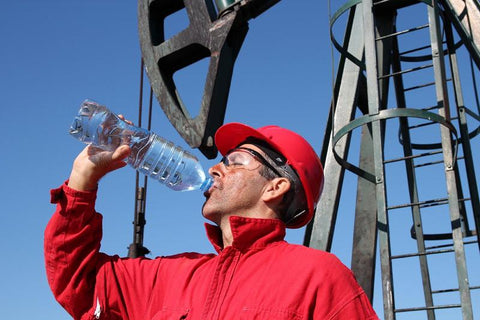Tips for Working in the Summer Heat to avoid Dehydration

There is no doubt that summer is one of our favorite seasons, but the heat and sun can bring hazards for those who must work outdoors. The combination of physical labor with heat and humidity can be grueling and even dangerous without taking the right precautions. Working on a hot day can cause accidents or lead to illnesses like prickly heat and heat cramps. The most severe forms of heat-related illness are heat exhaustion and heat stroke and are primarily caused by dehydration.
It’s important to recognize the warning signs of heat-related conditions and take quick action to prevent it from becoming fatal. Symptoms of heat exhaustion include weakness, dizziness, headaches, muscle cramps, and sweating, which can quickly progress into heat stroke. Heat stroke victims often don’t recognize their symptoms, so it’s up to a co-worker’s ability to detect that something is wrong. Symptoms of heat stroke include very high body temperature, profuse sweating, confusion, hallucinations, seizures, and loss of consciousness.
If you suspect you or a co-worker is suffering from a heat-related illness, seek medical help immediately. Ultimately, prevention is the best medicine. If you are one of the millions of Americans who have to work outdoors, follow these tips to minimize your risk of heat-related illness this summer and stay healthy and comfortable.
Acclimate
Heat acclimation plays a significant role in the body’s ability to cope with heat exposure. It’s a good idea to avoid strenuous activities until you are accustomed to the heat. It can take 1 to 2 weeks for a body to fully acclimate to a hot environment. When starting out, try easing into tasks gradually. Make sure to take breaks from the heat when needed.
Avoid Too Much Sun
Whenever possible, try to schedule the hardest and most physically demanding work for the early morning hours when the temperatures are less extreme. If you must work during the hottest hours of the day, consider sharing and rotating the workload with a co-worker in work-rest cycles. Check the forecast to schedule work-rest cycles that make the most sense for temperature predictions.
If you must work during the sunniest parts of the day, move tasks into the shade or indoors. Erecting a temporary shelter is a great way to avoid overexpose to the sun’s rays. Sometimes avoiding the sun isn’t possible, so make sure to take frequent breaks in a cool area.
Allow Yourself to Sweat
When you are working in the heat, never be afraid to sweat. Sweating is the most effective mechanism your body has for cooling off. Since cooling happens when sweat evaporates, try setting up a fan near your workspace to help keep your body temperature down.
Wear the Right Clothing
The right clothing can help keep you cool and protect your skin from UV rays. Cover up with loose-fitting clothes that are made with light and breathable fabric. You might be tempted to take your shirt off, but without a shirt and hat, the sun can dry your sweat too quickly and prevent it from cooling you down.
Stay Hydrated

Remember to drink plenty of water in hot weather. Start drinking water hours before your shift, so you are not starting the day with a fluid deficit. When you feel the urge for thirst act on it. Carry a bottle of water with you so fluid is always available or consider wearing a hydration backpack to keep your hands free.
